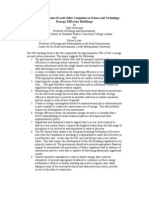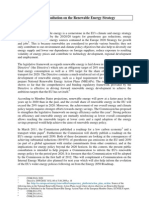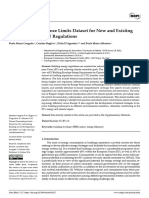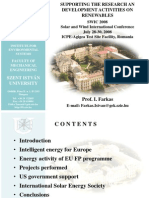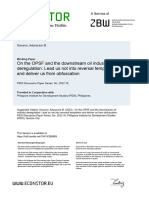0 ratings0% found this document useful (0 votes)
56 viewsDesign and Impact of A Harmonised Policy For Renewable Electricity in Europe
Design and Impact of A Harmonised Policy For Renewable Electricity in Europe
Uploaded by
lorejackThe document summarizes regional workshops held in Oxford, Prague, and Strasbourg to discuss renewable energy policy recommendations beyond 2020. At each workshop, stakeholders from EU countries discussed the need for predictable, clear renewable energy policies after 2020. While targets were generally agreed to provide investment certainty, some argued targets could increase costs by requiring long-term subsidies. The workshops aimed to incorporate feedback into practical post-2020 policy proposals within the beyond2020 project.
Copyright:
© All Rights Reserved
Available Formats
Download as PDF, TXT or read online from Scribd
Design and Impact of A Harmonised Policy For Renewable Electricity in Europe
Design and Impact of A Harmonised Policy For Renewable Electricity in Europe
Uploaded by
lorejack0 ratings0% found this document useful (0 votes)
56 views9 pagesThe document summarizes regional workshops held in Oxford, Prague, and Strasbourg to discuss renewable energy policy recommendations beyond 2020. At each workshop, stakeholders from EU countries discussed the need for predictable, clear renewable energy policies after 2020. While targets were generally agreed to provide investment certainty, some argued targets could increase costs by requiring long-term subsidies. The workshops aimed to incorporate feedback into practical post-2020 policy proposals within the beyond2020 project.
Original Description:
beyond 2020
Original Title
Design and impact of a harmonised policy for renewable electricity in Europe
Copyright
© © All Rights Reserved
Available Formats
PDF, TXT or read online from Scribd
Share this document
Did you find this document useful?
Is this content inappropriate?
The document summarizes regional workshops held in Oxford, Prague, and Strasbourg to discuss renewable energy policy recommendations beyond 2020. At each workshop, stakeholders from EU countries discussed the need for predictable, clear renewable energy policies after 2020. While targets were generally agreed to provide investment certainty, some argued targets could increase costs by requiring long-term subsidies. The workshops aimed to incorporate feedback into practical post-2020 policy proposals within the beyond2020 project.
Copyright:
© All Rights Reserved
Available Formats
Download as PDF, TXT or read online from Scribd
Download as pdf or txt
0 ratings0% found this document useful (0 votes)
56 views9 pagesDesign and Impact of A Harmonised Policy For Renewable Electricity in Europe
Design and Impact of A Harmonised Policy For Renewable Electricity in Europe
Uploaded by
lorejackThe document summarizes regional workshops held in Oxford, Prague, and Strasbourg to discuss renewable energy policy recommendations beyond 2020. At each workshop, stakeholders from EU countries discussed the need for predictable, clear renewable energy policies after 2020. While targets were generally agreed to provide investment certainty, some argued targets could increase costs by requiring long-term subsidies. The workshops aimed to incorporate feedback into practical post-2020 policy proposals within the beyond2020 project.
Copyright:
© All Rights Reserved
Available Formats
Download as PDF, TXT or read online from Scribd
Download as pdf or txt
You are on page 1of 9
Regional Dissemination Workshops
Design and impact of a harmonised policy for
renewable electricity in Europe
- Summary of presentations and discussions-
Location and Date: Oxford, September 18
th
, 2013
Prague, October 2
nd
, 2013
Strasbourg, November 20
th
, 2013
Summary of the events
The core objective of these regional workshops was to undertake a critical reflection on the draft final
results and recommendations of the beyond2020 project. The critical feedback has be incorporated into
the final work within this project, aiming to deliver a set of finely-tailored and practical policy recommen-
dations on the way forward for RES.
At the Prague event, a broad set of stakeholders (EU and national RES policy-makers, decision-makers
from the private sector, academics, and (RES) industry) from Central and Eastern Europe had the oppor-
tunity to discuss the RES policy agenda for tomorrow from both a national / regional and a European
perspective. Thus, in addition to attendees from the Czech Republic, key stakeholders from neighbouring
countries were also invited to attend this regional workshop in order to ensure the regional dissemination
character of the event.
At the Oxford event, a broad set of stakeholders (EU and national RES policy-makers, decision-makers
from the private sector, academics, and (RES) industry) had the opportunity to discuss the RES policy
agenda for tomorrow from both a national / regional and a European perspective. Thus, in addition to
attendees from the UK, key stakeholders from neighbouring countries were also invited to attend this
regional workshop in order to ensure the regional dissemination character of the event.
At the Strassbourg event the project team had the possibility to discuss directly with Members of the
European Parliament the key main findings of the project and provided recommendations and insights for
the current debate on renewable energy policy in Europe and in the Member States. The discussion
contributed to the political discussion on RES targets, the interactions with the ETS and prospects for
harmonisation at EU level after 2020.
There was general agreement among speakers and the audience that a degree of predictability, clarity
and stability was required to create and maintain a climate in which RES-E investments and policy frame-
work would continue and develop. The implications of this insight for the need for ongoing targets, how-
ever, were not unanimously agreed. For example, there was spirited discussion around the issue of
whether there was a need for an EU-level target for renewables after 2020. Some suggested that signifi-
cant progress had been made and that time was now needed for renewables to bed into the operation of
the market: the fear was that, otherwise, the need for subsidies for the ongoing operation of such RES-E
would become institutionalised, thus raising costs and reducing competition. On the other hand, others
argued that targets continued to be necessary to drive investment, R&D, innovation and deployment.
"With a suitable mix of three targets for climate protection, renewable and energy efficiency, and respec-
tive policy measures, the right balance between competition and risk could be better maintained said Dr.
Mario Ragwitz from the Fraunhofer ISI. He declared that such balance would trigger mass deployment of
low-cost options (e.g. through the ETS) while at the same time encouraging the smooth development of
less mature technologies, with positive effects on the European innovation capability and competitive-
ness.
The beyond2020 project at a glance
With Directive 2009/28/EC, the European Parliament and Council have laid
the grounds for the policy framework for renewable energies until 2020.
The aim of this proposed action is to look more closely beyond 2020 by
designing and evaluating feasible pathways of a harmonized European
policy framework for supporting an enhanced exploitation of renewable
electricity in particular, and RES in general. Strategic objectives are to
contribute to the forming of a European vision of a joint future RES policy
framework in the mid- to long-term and to provide guidance on improving
policy design.
The final outcome will be a finely-tailored policy package, offering a concise
representation of key outcomes, a detailed comparison of the pros and cons
of each policy pathway and roadmaps for practical implementation. The
project will be embedded in an intense and interactive dissemination
framework consisting of regional and topical workshops, stakeholder con-
sultation and a final conference.
Further information is available at: www.res-policy-beyond2020.eu.
Regional Dissemination Workshop in Oxford
Design and impact of a harmonised policy for renewable electricity in Europe
(Draft) Final results of the detailed RES policy assessment within the beyond2020 project
Location: The Cube lecture theatre, Faculty of Law, St Cross Road, Oxford, United Kingdom
Date: Wednesday, 18 September 2013 (10:30-16:30 BST)
Agenda:
10:30-11:00 Welcome coffee and registration
11:00-11:20
Welcome and Overview of the beyond2020 project
Gustav Resch, EEG
11:20-11:40
RES policy (beyond 2020) from a UK perspective
UK policy maker / expert (tbc)
11:40-12:00 Questions and discussion
12:00-12:20 Potential areas of difficulty under EU Law
Angus Johnston & Drte Fouquet, BBH / UOXF
12:20-12:40 Interactions between RES-Policies and Electricity Markets
Pedro Linares, Universidad Pontifica Comillas
12:40-13:00 Questions and discussion
13:00-14:00 Lunch Break
14:00-14:20 Final results of the cost-benefit analysis and quantitative assessment of RES
policy pathways beyond 2020. (Results WP4), Gustav Resch, EEG
14:20-14:40 Integrated policy assessment and strategic aspects, (draft) final results
Simone Steinhilber, Fraunhofer ISI
14:40-15:00 Questions and discussion
15:00-15:20 Coffee Break
15:20-15:40 Interacting policy aspects for RES beyond 2020
Isabelle de Lovinfosse , ECOFYS and Felipe Toro, IREES
15:40-16:00 Conclusions and recommendations on future RES policy design from the be-
yond2020 project
Gustav Resch, EEG
16:00-16:25 Final interactive discussion forum
16:25-16:30 Final wrap-up
Gustav Resch, EEG
16:30-Open Farewell Drinks
Key content / statements of the beyond2020 team and external speakers:
Presentations by Rob Watson (CMS Cameron McKenna) and Claes Hedenstrm (Vattenfall)
There was general agreement among speakers and the audience that a degree of predictability, clarity and
stability was required to create and maintain a climate in which RES-E investments would continue and develop.
The implications of this insight for the need for ongoing targets, however, were not unanimously agreed. For
example, there was spirited discussion around the issue of whether there was a need for an EU-level target for
renewables after 2020. Some suggested that significant progress had been made and that time was now
needed for renewables to bed into the operation of the market: the fear was that, otherwise, the need for
subsidies for the ongoing operation of such RES-E would become institutionalised, thus raising costs and
reducing competition. On the other hand, others argued that targets continued to be necessary to drive
investment, R&D, innovation and deployment.
It was also highlighted in discussion that both the EU and its Member States had to be careful not to damage
the fragile trust in RES-E promotion policy: the examples of the UKs abortive attempt retroactively to cut FIT
rates for household solar installations and Spains attempts to avoid the significant costs engendered by its
successful (in terms purely of deployment levels) RES-E promotion system were cited. The presence and
potential for legal rules to protect and defend the legitimate interests and expectations of various parties in
and under those (national) RES-E schemes was emphasised, although it was suggested that such successes (as
in the UK) can often be slow and under-reported, so that the damage to trust in such systems may be difficult
to repair.
Finally, it was stressed that there was a need for definitional clarity when talking about renewables and the
scope of the term. For example, in some countries the role of renewables outside the electricity generation
sector is crucial (e.g. biomass for heating in the Nordic countries, and transport-related energy generation and
consumption), which raises specific questions and demonstrates the need to pay close attention to national
specificities. Thus, while broader biofuels policies might suggest one approach, the use of biomass for CHP in
some areas might require individual attention, lest significant local cost and logistical difficulties be the result.
Presentations by Angus Johnston & Eva van der Marel (University of Oxford) and Pedro Linares
(Universidad Pontifica Comillas)
There was much discussion of the various assumptions made in building the electricity market models used, as
well as the way in which the data had been presented.
Concerning the legal presentation, the implications of any future EU-level legislation for domestic RES-E systems
was addressed, in particular the relationship between such legislation and the ongoing State aid assessment of
national support schemes. Returning to the point relating to stability and certainty, it was suggested that a
preference for less intensive and less far-reaching EU-level harmonization legislation clashed with a desire for
greater stability and certainty for investors and market actors. This led into a discussion of the Commissions
ongoing review of its State aid legislation (block exemption Regulation) and guidelines (especially on
environmental support generally, and RES-E support schemes in particular), and its potential implications for
the landscape within which any future EU-level renewables legislation would have to function. There was
concern that Commission policy adopted in specific RES-E guidelines might achieve harmonization by the back
door of preferable or acceptable types of national RES-E support schemes; in the absence of official proposals,
it was difficult to comment on such fears in any detail, although it was acknowledged that if such back door
harmonization were pursued by the Commission, there might be questions about its competence to do so,
especially in light of the shared competence granted by Article 194 TFEU and the roles of the Council and the
European Parliament in the exercise of that competence.
Presentations by Gustav Resch (TU Wien / EEG) and Simone Steinhilber (Fraunhofer ISI)
The first discussion point concerned the possible scope for higher RES-E and/or ETS targets, given that the
Commissions approach seemed to aim for 80% emissions reductions (expecting the rest to be met by
international trading of allowances/permits or equivalents), whereas the Council had stated that there was a
need to pursue reductions of 80 to 95%. The fear was that, if the EU did not constantly push towards this higher
target, the pressure to achieve such goals would be removed (or at least worryingly reduced). The Beyond 2020
project had taken the Commissions Roadmap to 2050 as its reference point and it was felt that trying to insist
on significantly greater reductions might prove unrealistic in the present political climate, although it was
acknowledged that the pressure to make reductions needed to be maintained.
It was also suggested that a wider range of the co-benefits of RES-E should be taken into account when
assessing the viability and cost-effectiveness of any future EU-level RES-E promotion regime. It was
acknowledged that this, among various other possible benefits and effects, would be useful to include in the
analysis; at the same time, the difficulty was the ability to acquire accurate and reliable data to make such an
assessment in a clear and verifiable fashion.
There was then discussion concerning possible differences in costs (etc) levels between different types of
support scheme (e.g. FIP, FIT vs. Quotas, TGCs, etc). Even if one were to reject a simplistic, EU-wide TGC-based
system, one could nevertheless envisage a more differentiated approach (e.g. TGC for large-scale generation,
and a different tier for R&D in un(der)developed technologies): some USA-based examples might be pursued in
this vein. It was acknowledged that, of course, a more complex and differentiated EU system (incorporating
national-level variations, etc) could be developed (or indeed maintained). One example of such differentiation
could be seen as the approach of banding TGCs in various countries (like the UK) or offering different premium
or tariff levels depending upon the RES-E technology being supported.
It was objected that, if the EU were to adopt a requirement that all national systems use a FIT/FIP system, this
would remove all competition because the result would be regulated prices (unlike, in theory, TGC-based
systems). In reply, it was stressed that price competition was not the only relevant and important type of
competition in such activities: development, innovation, deployment, efficient operation (etc) could all be
incentivised under a FIT/FIP system, thus creating significant competition over time between various actors up
and down the value/distribution chain.
Presentations by Felipe Toro (IREES) and Isabele de Lovinfosse (Ecofys)
In assessing the international competitiveness implications of internal EU RES-E rules for domestic EU
business, the methodology of how to assess the various factors involved might perhaps draw some lessons
from current EU practice in analogous areas. The presentation mentioned the free allocation procedure under
the EU ETS; other possible areas of interest might include the EUs anti-dumping rules, and perhaps even the
WTOs rules under the Agreement on Subsidies and Countervailing Measures.
With regard to the interaction between the EUs policies and rules on RES-E and the ETS, it was acknowledged
that some co-ordination between the two had been attempted, but that other developments (recession and
resulting emissions reductions, e.g.) had not been foreseen when such co-ordination had been pursued.
Further, the issue of how to account for such interactions in future was raised, including the need to be careful
about how much should be pursued ex ante (i.e. at the design stage or, at least, prior to each round of
allocation/auction) and what should be left to ex post adjustments (and how, and by which body). Lessons
might learnt here from work on energy efficiency and dynamic baselines, and more generally any such
interactions analysis should also endeavour to cover the impact of energy efficiency developments.
Finally, there was lively discussion about the logistics of rules which would allow adjustment of the EU ETS.
Some advocated a move to a carbon tax, while others acknowledged that, although that might be attractive,
this would be politically very difficult at this stage. Others recommended a progressive move of ever more
emissions sectors into the traded sector, thus reducing the distortions which might be caused at the edge of the
scope of the ETS but where RES-E obligations might still apply. Another issue concerned the design of legal rules
to specify the trigger for, and the extent of the power to effect, ex post intervention, which led to a discussion
of the recent difficulties in securing European Parliament approval of the amendment to the current EU ETS to
allow such ex post interventions by the Commission and the limited scope of the rules finally adopted.
Regional Dissemination Workshop in Prague
Design and impact of a harmonised policy for renewable electricity in Europe
Final results of the detailed RES policy assessment within the beyond2020 project
Location: Grand Hotel Bohemia (Room Boccaccio), Kralodvorska 4, Prague, Czech Republic
Date: Wednesday, 2 October 2013 (10:30-17:30 CET)
Agenda:
10:00-10:30 Welcome coffee and registration
10:30-10:40
Welcome from Czech Technical University (CVUT) in Prague
Jaroslav Knapek, CVUT
10:40-11:00
Welcome and Overview of the beyond2020 project
Christian Panzer, EEG
11:00-11:15 Questions and discussion
11:15-11:40 Final results of the cost-benefit analysis and quantitative assessment of RES
policy pathways beyond 2020
Christian Panzer, EEG
11:40-12:10 Potential areas of difficulty under EU Law
Angus Johnston & Jana Nysten BBH / UOXF
12:10-12:40 Questions and discussion
12:40-13:50 Lunch Break
13:50-14:20 Integrated policy assessment and strategic aspects, (draft) final results
Simone Steinhilber, Fraunhofer ISI
14:20-14:40 Interacting policy aspects for RES beyond 2020
Corinna Klessmann, ECOFYS and Felipe Toro, IREES
14:40-15:00 Interactions between RES-Policies and Electricity Markets
Marian Klobasa, Fraunhofer ISI
15:00-15:20 Questions and discussion
15:20-15:40 Coffee Break
15:40-16:00 RES policy (beyond 2020) in the Czech Republic
Martin Latvka, Representatives from Energy regulatory office in the Czech
Republic
16:00-16:15 RES policy (beyond 2020) in the Czech Republic
Pavel Gebauer, Representative from Ministry of industry and trade in the Czech
Republic
16:15-16:40 Final interactive discussion
16:40-16:50 Conclusions and recommendations on future RES policy design from the be-
yond2020 project
Christian Panzer, EEG
16:50-17:30 Farewell Coffee
Key content / statements of the beyond2020 team and external speakers:
Presentations by Christian Panzer (TU Wien / EEG)
The topic of discussion was the final results of the cost-benefit analysis and quantitative assessment of RES
policy pathways beyond 2020. The basic discussion was centred on the level of harmonization that could be
applied regarding the fact that a full harmonization level was unlikely to be agreed among the EU Members.
Presentations of Angus Johnston (UOXF) and Jana Nysten (BBH)
Potential areas of difficulty under EU Law: The discussion was as well as in the last presentation with respect to
the EU compliance of the different harmonization levels, regarding the agreements. A soft or minimum
harmonization level is presented as legally feasible while other higher levels of harmonization would need an
exemption from the court. Some comments about progressive harmonization were made, referring to the fact
of applying soft harmonization and tendering its way to a medium harmonization level.
Pavel Gebauer (Representative from Ministry of industry and trade in the Czech Republic)
Main topic was the RES policy in the Czech Republic and planned switch of RES support from operational
support to the support of low carbon technologies incl. RES. The representative from the Ministry of industry
and trade gave insights on the development on renewables, biomass being the main supported type of
renewable energy source in Czech Republic. Also a new legislation is to implement for pipelines on low carbon
technologies to reduce CO2, other legislations that were being developed at that moment were for
cogeneration technologies. At last the main concern of the Czech agenda is cost efficiency in the industry and
reduction of very high impact of RES support on electricity prices (to keep competitiveness of the Czech
industry). He also mentioned high potential for energy savings and for the increase of energy efficiency in the
Czech Republic.
Lubos Vrbata (Representative from Energy Regulatory Office in the Czech Republic)
The main topic was the presentation of present figures on RES power generation and RES financial support and
presentations of major currently discussed ideas for changes in RES support scheme. ERO representative high-
lighted the total value of financial RES support (for power generation) on the level 1777 mil. EUR (expected
value for 2013). FIT and green bonuses introduced into the support scheme created good incentives for the
investors which resulted in rapid growth of RES power generation. But the way of RES support (support of all
RES types without to the link to economic effectiveness) has led to the quickly growing power prices both for
households and the industry. The other imperfections of the support scheme between 2006 and 2012 were lack
of financial limits for support and the absence of other stopping mechanisms. He presented major ideas for RES
support after the year 2015 orientation to the most effective domestic sources (e.g. biomass), creation of
motivation to use RES preferably for own consumption or for consumption on the regional level and also moti-
vation to increase efficiency of already running projects). He also highlighted possible switch from operational
support to the investment support (in relation to effectiveness of carbon emissions savings).
Parliamentary Breakfast in Strasbourg
Design and impact of a harmonised policy for renewable electricity in Europe
Final results of the detailed RES policy assessment within the beyond2020 project
Location: European Parliament, Strasbourg
Date: Wednesday, 20 November 2013 (8:00-9:00)
Agenda:
8:00-8:15
Welcome by Claude Turmes, MEP
8:15-8:20
The beyond2020 project at a glance
Gustav Resch & Mario Ragwitz, TU Wien / EEG & Fraunhofer ISI
8:20-8:30
Legal aspects - potential areas of difficulty under EU Law
Emmanuelle Raoult, BBH
8:30-8:40
Cost-benefit analysis, key results of the quantitative assessment of RES policy
pathways beyond 2020; Gustav Resch, TU Wien / EEG
8:40-8:50
Integrated policy assessment and strategic aspects
Simone Steinhilber, Fraunhofer ISI
8:50-9:00
Discussion
Key content / statements of the beyond2020 team:
Modelling results from the TU Vienna consortium indicated that if the ETS were the only instrument applied,
this would result in a renewables share of only about 26 percent in 2030, compared to 31.2 percent in the other
analyzed scenarios. However, renewables drive down wholesale electricity prices through the so-called merit
order effect on the electricity and CO
2
markets. A lower renewables share would save on support costs for
renewables, but would also see higher wholesale electricity and CO
2
prices, thus resulting in roughly the same
financial burden to electricity consumers. "We can have more renewables at the same cost but for doing so a
clear commitment is needed, and a binding 2030 renewables target is a forward-looking first step in this direc-
tion" said Dr. Gustav Resch from the Energy Economics Group at TU Vienna.
Additionally, Fraunhofer ISI has calculated a 41 percent cost-effective end-use energy savings potential for 2030.
This result was based on a detailed bottom-up assessment of the energy savings potential in individual sectors
by Fraunhofer ISI: industry (21 percent), residential (61 percent), tertiary (38 percent) and transport (41 per-
cent). Realizing this potential would result in 240bn net savings per year in 2030 on energy bills for household-
ers and industry in Europe. Thus, a reasonable 2030 target for energy efficiency appears highly beneficial and
would help the consumers further to lower their energy costs.
"With a suitable mix of three targets for climate protection, renewable and energy efficiency, and respective
policy measures, the right balance between competition and risk can be better maintained said Dr. Mario
Ragwitz from the Fraunhofer ISI. This would trigger mass deployment of low-cost options (e.g. through the ETS)
while at the same time encouraging the smooth development of less mature technologies, with positive effects
on the European innovation capability and competitiveness.
You might also like
- An Annotated Explanation of Articles 1 and 2 of The WTODocument3 pagesAn Annotated Explanation of Articles 1 and 2 of The WTOjasminjajarefeNo ratings yet
- Reactorul Rapid Racit Cu Plumb TopitDocument104 pagesReactorul Rapid Racit Cu Plumb TopitLazarescu ElenaNo ratings yet
- 2010 07 02 Energy Strategy Results 0Document11 pages2010 07 02 Energy Strategy Results 0Pablo Puñal FieiraNo ratings yet
- Ip 03 1229 - enDocument3 pagesIp 03 1229 - enbxlmichael8837No ratings yet
- CA3 BOOK 2012 Ebook 201310Document374 pagesCA3 BOOK 2012 Ebook 201310hb_scribNo ratings yet
- Handbook: Holistic Energy Efficient Planning and ConstructionDocument5 pagesHandbook: Holistic Energy Efficient Planning and ConstructionPopescoPopoviciuNo ratings yet
- Hydrogen Europe Research Research Position Paper February 2022Document29 pagesHydrogen Europe Research Research Position Paper February 2022Jesús Javier Antuña CouceiroNo ratings yet
- Energy Efficient BuildingsDocument6 pagesEnergy Efficient BuildingsRinu Mary VargheseNo ratings yet
- 2017-10!18!19-Summary of The 6th EUSDR Annual Forum-H-Bp (1a) AngolDocument3 pages2017-10!18!19-Summary of The 6th EUSDR Annual Forum-H-Bp (1a) AngolReálzöldek Reális Zöldek KlubNo ratings yet
- MJ0320335ENN enDocument487 pagesMJ0320335ENN ennickybudauNo ratings yet
- Renewable Energy StrategyDocument10 pagesRenewable Energy Strategydanb1No ratings yet
- EEOS Their Future in The EUDocument15 pagesEEOS Their Future in The EUkemredserbiaNo ratings yet
- Unlocking the hydrogen economy — stimulating investment across the hydrogen value chain: Investor perspectives on risks, challenges and the role of the public sectorFrom EverandUnlocking the hydrogen economy — stimulating investment across the hydrogen value chain: Investor perspectives on risks, challenges and the role of the public sectorNo ratings yet
- Z. Nagy/L. Gîlia/R. Ballok Romanian Application of Cold-Formed Steel Beams With Screwed Corrugated WebsDocument1 pageZ. Nagy/L. Gîlia/R. Ballok Romanian Application of Cold-Formed Steel Beams With Screwed Corrugated WebsyouhsarahNo ratings yet
- GHGT10 Paper BrunstingDocument7 pagesGHGT10 Paper Brunstingalanbatista_santosNo ratings yet
- European Hydrogen and Fuel Cell Projects (2004)Document72 pagesEuropean Hydrogen and Fuel Cell Projects (2004)killaforniaNo ratings yet
- Carbon Budgets For Buildings: Harmonising Temporal, Spatial and Sectoral DimensionsDocument24 pagesCarbon Budgets For Buildings: Harmonising Temporal, Spatial and Sectoral DimensionsWalid MghazliNo ratings yet
- Ooperation ORK Rogramme: (European Commission C (2010) 4900 of 19 July 2010)Document13 pagesOoperation ORK Rogramme: (European Commission C (2010) 4900 of 19 July 2010)Marcial ValmoriscoNo ratings yet
- Eprs Stu (2021) 697199 enDocument103 pagesEprs Stu (2021) 697199 enmerlinakisNo ratings yet
- Cities Advice For Sustainable Housing - Sophie MoreauDocument75 pagesCities Advice For Sustainable Housing - Sophie MoreauEcosistema Urbano100% (2)
- Mpiep 20 Cedi WP 12Document17 pagesMpiep 20 Cedi WP 12Carlos Henrique SantanaNo ratings yet
- Executive Summary: The European Policy ContextDocument7 pagesExecutive Summary: The European Policy ContextAkshay GoelNo ratings yet
- 2016 01 11 - MEPs Manifesto Northern Seas Final For WebDocument5 pages2016 01 11 - MEPs Manifesto Northern Seas Final For Webgeorg6915No ratings yet
- data-09-00127Document8 pagesdata-09-00127Sumeja LepićNo ratings yet
- EFFESUS Methodology For Assessing The ImDocument20 pagesEFFESUS Methodology For Assessing The ImTatianaNo ratings yet
- Hydrogen Synopses enDocument188 pagesHydrogen Synopses enRob ten NapelNo ratings yet
- Economic Analysis of Cost of EvaluationDocument156 pagesEconomic Analysis of Cost of EvaluationMiracle UzuegbuNo ratings yet
- Hungarian Energy Strategy 2030Document132 pagesHungarian Energy Strategy 2030kjhathiNo ratings yet
- European Energy Saving Guide 2016: of The European Association For External Thermal Insulation Composite Systems (EAE)Document48 pagesEuropean Energy Saving Guide 2016: of The European Association For External Thermal Insulation Composite Systems (EAE)Εύη ΣαλταNo ratings yet
- Ooperation ORK Rogramme: (European Commission C (2009) 5893 of 29 July 2009)Document12 pagesOoperation ORK Rogramme: (European Commission C (2009) 5893 of 29 July 2009)Giuseppe ZileniNo ratings yet
- Energy-System Modelling of The EU Strategy Towards Climate-NeutralityDocument15 pagesEnergy-System Modelling of The EU Strategy Towards Climate-NeutralitypcaprosNo ratings yet
- Eae Welcomes Alignment of The Epbd With Higher AmbitionsDocument4 pagesEae Welcomes Alignment of The Epbd With Higher AmbitionsΕύη ΣαλταNo ratings yet
- Implementation of The Energy Efficiency directive-QA0216291ENNDocument170 pagesImplementation of The Energy Efficiency directive-QA0216291ENNnikoskasim1970No ratings yet
- Commission of The European CommunitiesDocument32 pagesCommission of The European Communitiesrobnet-1No ratings yet
- Levelised Cost of Hydrogen On Proposed Electrolyser - NLDocument33 pagesLevelised Cost of Hydrogen On Proposed Electrolyser - NLKapil NarulaNo ratings yet
- BPIE Renovating Romania en 2014Document56 pagesBPIE Renovating Romania en 2014GregNo ratings yet
- Policy reflections on the European energy system and infrastructure. Non-paper on a joint vision for actions by the European CommissionDocument5 pagesPolicy reflections on the European energy system and infrastructure. Non-paper on a joint vision for actions by the European CommissionAkshay MohanNo ratings yet
- 090166e5e521146bDocument2 pages090166e5e521146bilerazymipowiezenazwajestzlaNo ratings yet
- Department of Physics and Process ControlDocument45 pagesDepartment of Physics and Process ControlMenthor555No ratings yet
- EU Funding Sustainable Energy - ERRIN and Others - 27.6.2013Document20 pagesEU Funding Sustainable Energy - ERRIN and Others - 27.6.2013MN Titas TitasNo ratings yet
- BWEA - Offshore Wind Energy DevelopmentsDocument32 pagesBWEA - Offshore Wind Energy DevelopmentsnikifNo ratings yet
- Best Practice Guidelines - Offshore Wind Energy Development - BWEA - 2002Document32 pagesBest Practice Guidelines - Offshore Wind Energy Development - BWEA - 2002Pradosh Kumar50% (2)
- Master Thesis Bineke VismanDocument190 pagesMaster Thesis Bineke VismanPavanNo ratings yet
- EU-China Energy Magazine 2021 Summer Issue: 2021, #2From EverandEU-China Energy Magazine 2021 Summer Issue: 2021, #2No ratings yet
- Bull 2011 - 3Document10 pagesBull 2011 - 3Anonymous fMgsG0GQVHNo ratings yet
- European Union Energy ProposalDocument7 pagesEuropean Union Energy ProposalTheophilus AshiabieNo ratings yet
- 2020 Buildingandcities CarbonbudgetDocument25 pages2020 Buildingandcities CarbonbudgetLiriel MartinsNo ratings yet
- EÓLICA - Spatial Planning of WindturbinesDocument40 pagesEÓLICA - Spatial Planning of WindturbinesCognosferaNo ratings yet
- Morocco PTX IRENA Session-SummaryDocument6 pagesMorocco PTX IRENA Session-Summaryu06l4j3bNo ratings yet
- EU China Energy Magazine 2022 June Issue: 2022, #5From EverandEU China Energy Magazine 2022 June Issue: 2022, #5No ratings yet
- 4 Review of PV Solar Energy Development 2011 2021 in Central European CountriesDocument18 pages4 Review of PV Solar Energy Development 2011 2021 in Central European Countrieskiettt2108No ratings yet
- Quantity MeasuresDocument43 pagesQuantity MeasuresGaurav MishraNo ratings yet
- Guide: Energy Technology RoadmapsDocument32 pagesGuide: Energy Technology RoadmapsElizabeth CoxNo ratings yet
- Synthesis Report On The Assessment of Member states-LDNA27722ENNDocument125 pagesSynthesis Report On The Assessment of Member states-LDNA27722ENNnikoskasim1970No ratings yet
- Potential Areas of Conflict With EU Law (Beyond2020 - D3-1)Document76 pagesPotential Areas of Conflict With EU Law (Beyond2020 - D3-1)LaniNo ratings yet
- EN EN: Commission of The European CommunitiesDocument14 pagesEN EN: Commission of The European Communitiesuakauaka31416No ratings yet
- 2016 11 Tools Energy Efficient BuildingsDocument40 pages2016 11 Tools Energy Efficient Buildingssheni timNo ratings yet
- The Policy Framework For The Promotion of Hydrogen and Fuel Cells in Europe: A Critical AssessmentDocument33 pagesThe Policy Framework For The Promotion of Hydrogen and Fuel Cells in Europe: A Critical AssessmentEKAI CenterNo ratings yet
- Energias ActualizadoDocument23 pagesEnergias ActualizadomariapergonNo ratings yet
- Sustainability 09 00272Document26 pagesSustainability 09 00272sami.ben.slimannNo ratings yet
- Guidance in Public BuildingsDocument64 pagesGuidance in Public Buildingsngochung1992No ratings yet
- Market FailureDocument26 pagesMarket Failurepratishdassani12No ratings yet
- Essar Ar2012Document153 pagesEssar Ar2012Hiren TarapraNo ratings yet
- Nliu Law Review 2019 Fina BookDocument231 pagesNliu Law Review 2019 Fina BookAshhab KhanNo ratings yet
- Strategic Management Assignment (Amul) PDFDocument10 pagesStrategic Management Assignment (Amul) PDFShruti NagmoteNo ratings yet
- TNPSC Current Affairs - TNPSC Monthly Current AffairsDocument4 pagesTNPSC Current Affairs - TNPSC Monthly Current AffairsramkumarlakshmanansivakasiNo ratings yet
- Principles of Economics - Problem Set 5 Conceptual QuestionsDocument3 pagesPrinciples of Economics - Problem Set 5 Conceptual QuestionsantialonsoNo ratings yet
- Agricultural Price PolicyDocument12 pagesAgricultural Price PolicyZahid Ali100% (1)
- INTERNATIONAL Trade LAW PROJECTDocument21 pagesINTERNATIONAL Trade LAW PROJECTAnwesha Tripathy100% (1)
- Questions For Case Study AssignmentDocument5 pagesQuestions For Case Study Assignmentricky_everNo ratings yet
- Command of Evidence 1Document17 pagesCommand of Evidence 1Thuần PhạmNo ratings yet
- CeaDocument202 pagesCearafiqueNo ratings yet
- The Political Environment: A Critical Concern: International MarketingDocument62 pagesThe Political Environment: A Critical Concern: International MarketingaffenpinscherNo ratings yet
- Case Sugarcane Pricing in Uttar PradeshDocument24 pagesCase Sugarcane Pricing in Uttar PradeshsudhiNo ratings yet
- Topic 8 Protectionism and Free TradeDocument9 pagesTopic 8 Protectionism and Free Tradelungisanidlamini831No ratings yet
- SOC SCI 104 - Pre and Post Test ExamDocument1 pageSOC SCI 104 - Pre and Post Test ExamarciblueNo ratings yet
- Africa Agribusiness Report 2013Document162 pagesAfrica Agribusiness Report 2013itzfaizan100% (1)
- 19.arguments For and Against ProtectionismDocument4 pages19.arguments For and Against ProtectionismYumna ShakirNo ratings yet
- Risk and UncertaintyDocument4 pagesRisk and Uncertaintymuchaij063No ratings yet
- Mckinsey - Unlocking Potential of City RevenuesDocument9 pagesMckinsey - Unlocking Potential of City RevenuesMeriem AchouraNo ratings yet
- On The OPSF and The Downstream Oil Industry Deregulation: Lead Us Not Into Reversal Temptation and Deliver Us From ObfuscationDocument27 pagesOn The OPSF and The Downstream Oil Industry Deregulation: Lead Us Not Into Reversal Temptation and Deliver Us From ObfuscationBeverlyne MokayaNo ratings yet
- Om - Location DecisionsDocument14 pagesOm - Location DecisionsMarissa C BautistaNo ratings yet
- Public Finance 30 Questions and 30 AnswersDocument49 pagesPublic Finance 30 Questions and 30 AnswersopemiposioladunniNo ratings yet
- PDFDocument18 pagesPDFRakhi SomkuwarNo ratings yet
- Determinants of Farmers' Demand For Rice and Corn Crop Insurance in Tabuk City, KalingaDocument35 pagesDeterminants of Farmers' Demand For Rice and Corn Crop Insurance in Tabuk City, KalingarosabelalebsNo ratings yet
- Economic - Financial - Social Cost Benefit AnalysisDocument11 pagesEconomic - Financial - Social Cost Benefit AnalysisProfessor Tarun Das100% (1)
- Fran Smith - Reform US Agriculture ProgramsDocument1 pageFran Smith - Reform US Agriculture ProgramsCompetitive Enterprise InstituteNo ratings yet
- The Basics of Foreign Trade and Exchange - Economic Education..Document30 pagesThe Basics of Foreign Trade and Exchange - Economic Education..William FanNo ratings yet
- ABCs of Affordable Housing in Kenya Good - pk9lEH0oDocument21 pagesABCs of Affordable Housing in Kenya Good - pk9lEH0oMujjo Sahb100% (1)
- Tesla Pricing Strategy Analysis: Take Model 3 As An Example: Jiangxi Ding, Yuting HeDocument5 pagesTesla Pricing Strategy Analysis: Take Model 3 As An Example: Jiangxi Ding, Yuting HePhương ThảoNo ratings yet







